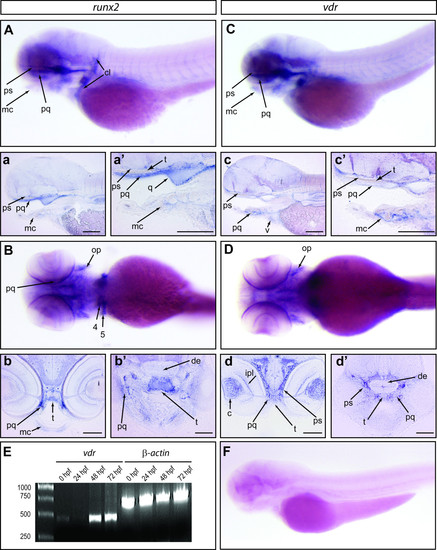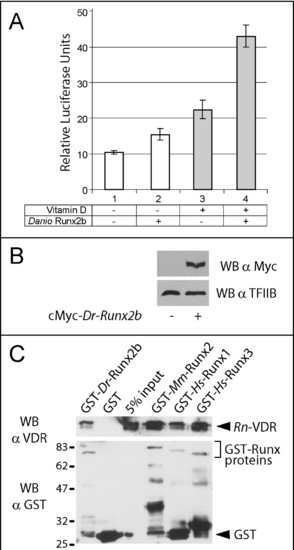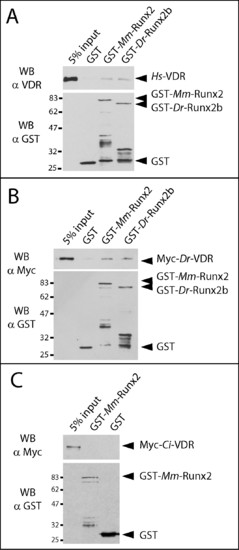- Title
-
Evolution of the interaction between Runx2 and VDR, two transcription factors involved in osteoblastogenesis
- Authors
- Marcellini, S., Bruna, C., Henríquez, J.P., Albistur, M., Reyes, A.E., Barriga, E.H., Henríquez, B., and Montecino, M.
- Source
- Full text @ BMC Evol. Biol.
|
Expression pattern of Runx2b and VDR in Danio rerio. An in situ hybridization of a 72 hpf zebrafish embryo hybridized with a Runx2b antisense probe is shown in a lateral (A) and ventral (B) view. The images in a and a′ are sagittal sections of the specimen shown in A. The images in b and b′ are transversal sections of the specimen shown in B. An in situhybridization of a 72 hpf zebrafish embryo hybridized with a VDR antisense probe is shown in a lateral (C) and ventral (D) view. The images in c and c′ are sagittal sections of the specimen shown in C. The images in d and d′ are transversal sections of the specimen shown in D. (E) RT-PCR performed on cDNA from zebrafish embryos at 0, 24 hpf, 48 hpf and larvae at 72 hpf with primers specific for VDR and β-actin. The molecular weight standard is shown on the left. (F) Lateral view of a 72 hpf zebrafish larvae hybridized with a VDR sense probe. Abbreviations: c, crystalline; cl, cleithrum; de, diencephalon; ipl, inner plexiform layer; mc, meckel cartilage; op, operculum; pq, palate quadrate; ps, parasphenoid; q, quadrate; t, trabecula; v, ventricle; 4 and 5, the IV and V branchial cartilage territories, respectively. The scale bar in a, a′, b, b′, c, c′, d and d′ represents 50 micrometers. EXPRESSION / LABELING:
|
|
The teleost Runx2b is functional in mammalian osteoblasts and interacts with the 1α,25-dihydroxyvitamin D3 pathway. (A) ROS17/2.8 osteoblasts were co-transfected for 12 hours with a Myc-tagged version of the Danio Runx2b homologue and the promoter of the rat osteocalcin driving the expression of the luciferase reporter gene. Cells were subsequently incubated for 18 hours in the absence (white bars) or in the presence (grey bars) of 1α,25-dihydroxyvitamin D3 (Vitamin D) before being assayed for relative Luciferase activity. (B) Western blot performed on nuclear extracts from ROS17/2.8 cells transfected or not with the Danio Runx2b homologue. (C) Nuclear extracts (150 μg) from ROS 17/2.8 cells cultured in the presence of 10-8 M 1α,25-dihydroxyvitamin D3 for 18 h were incubated with GST or with the indicated GST fusion proteins (1.5 μg) previously bound to 20 μl of glutathione-Sepharose beads. Precipitated VDR (upper panel) and GST-Runx (lower panel) proteins were then detected by Western blotting. The migration of molecular weight standards is indicated on the left. |
|
The Runx-VDR interaction is well conserved between osteichthyan vertebrate species. GST or the indicated GST-Runx2 fusion proteins (1.5 μg) previously bound to 20 μl of glutathione-Sepharose beads were incubated with the recombinant VDR homologue from Homo sapiens (A) or Danio rerio (B). The Danio rerio VDR protein is not recognized by the anti-VDR antibody (not shown) and was therefore tagged with an N-terminal Myc epitope. Precipitated VDR (upper panel) and GST-Runx2 (lower panel) proteins were then detected by Western blotting. (C) The recombinant VDR homologue from Ciona intestinalis (bearing a Myc epitope in its N-terminal) was incubated with GST or the indicated GST fusion proteins (1.5 μg) previously bound to 20 μl of glutathione-Sepharose beads. Precipitated VDR (upper panel) and GST-Runx2 (lower panel) proteins were then detected by Western blotting. Abbreviations: Dr, Danio rerio; Mm, Mus musculus; Hs, Homo sapiens; Ci, Ciona intestinalis. The migration of molecular weight standards is indicated on the left. |



